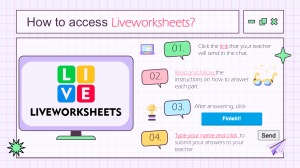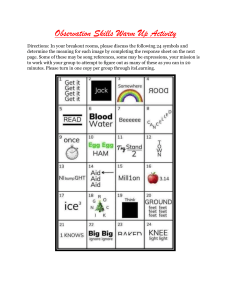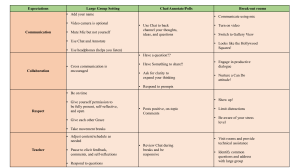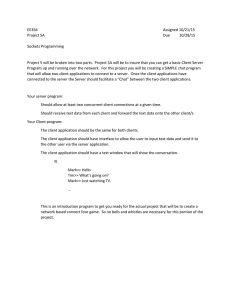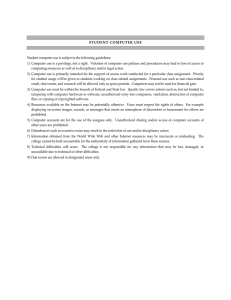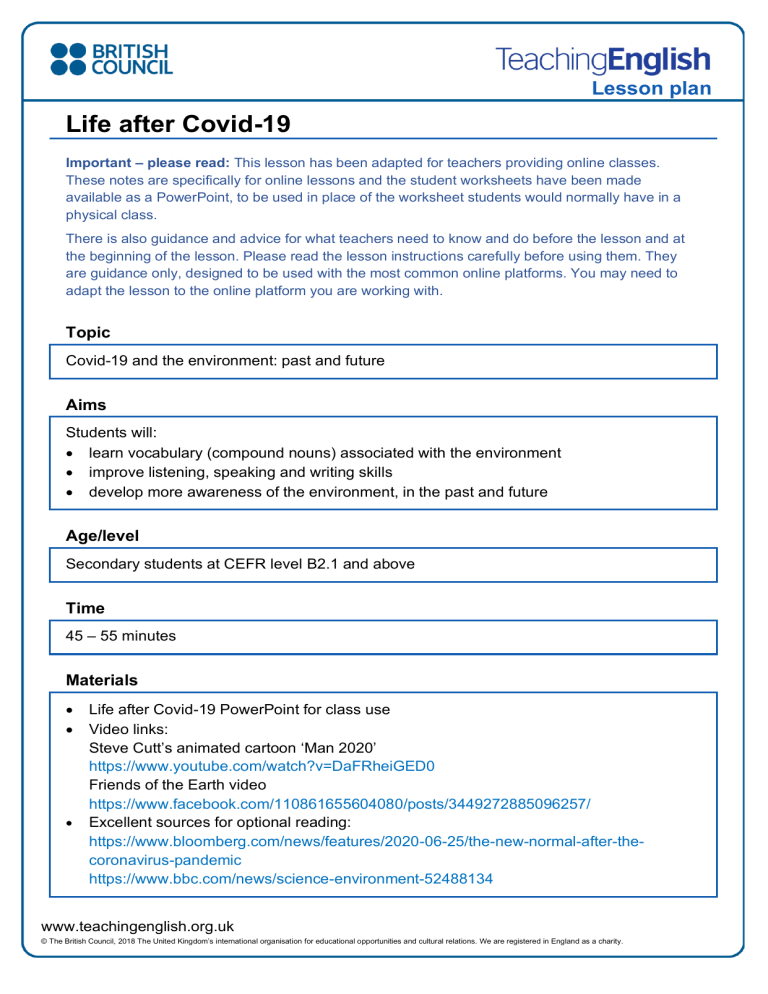
Lesson plan Life after Covid-19 Important – please read: This lesson has been adapted for teachers providing online classes. These notes are specifically for online lessons and the student worksheets have been made available as a PowerPoint, to be used in place of the worksheet students would normally have in a physical class. There is also guidance and advice for what teachers need to know and do before the lesson and at the beginning of the lesson. Please read the lesson instructions carefully before using them. They are guidance only, designed to be used with the most common online platforms. You may need to adapt the lesson to the online platform you are working with. Topic Covid-19 and the environment: past and future Aims Students will: • learn vocabulary (compound nouns) associated with the environment • improve listening, speaking and writing skills • develop more awareness of the environment, in the past and future Age/level Secondary students at CEFR level B2.1 and above Time 45 – 55 minutes Materials • • • Life after Covid-19 PowerPoint for class use Video links: Steve Cutt’s animated cartoon ‘Man 2020’ https://www.youtube.com/watch?v=DaFRheiGED0 Friends of the Earth video https://www.facebook.com/110861655604080/posts/3449272885096257/ Excellent sources for optional reading: https://www.bloomberg.com/news/features/2020-06-25/the-new-normal-after-thecoronavirus-pandemic https://www.bbc.com/news/science-environment-52488134 www.teachingenglish.org.uk © The British Council, 2018 The United Kingdom’s international organisation for educational opportunities and cultural relations. We are registered in England as a charity. Lesson plan Introduction During this lesson, students will consider the impact that the pandemic had on the environment and ask themselves if they want to go back to ‘normal’ - to life as it was before the pandemic. They begin by watching a clever animated cartoon showing how the planet healed while humans were in lockdown. Next, they will study some useful compound nouns and apply these to examples of life before and during the pandemic. The focus from here on is about the future, including a discussion and a video from Friends of the Earth. Finally, students will send some ideas to the United Nations in the form of a simple manifesto, with photos and hopes for the future. Before the lesson CHECKLIST • Always make sure you are familiar with the online platform you are using. - Have you tested your microphone and camera to make sure they work? Always do this before the less to check for any problems. - Do the students need a URL to join the online classroom? Do they all have this? - Do you know how to ‘mute’ the students’ microphones if you need to? - Do you know how to share what is on your computer screen so that the students can see it? - Do you know how to use ‘breakout rooms’ if you have this facility? Is this enabled? • Make sure that you have the student PowerPoint file open on your computer, and any other material you will be using during the lesson. • Make sure you are able to share what is on your computer screen with your students, so that they can all see it. Always check with your students that they can see what you are sharing. Most online learning platforms have a simple ‘raise hand’ button that can be used to check if students can see what you are showing on the screen or can hear what you are saying. • Most online platforms have support videos or tutorials available online. Do you know where to access these? • Make sure all of your students know they must arrive on time and that they have pen and paper. Many online learning platforms have a virtual waiting room. It is a good idea to tell your students to join the class at least 5 minutes before the lesson begins to avoid disruption. www.teachingenglish.org.uk © The British Council, 2018 The United Kingdom’s international organisation for educational opportunities and cultural relations. We are registered in England as a charity. Lesson plan Stage Lead-in (10-15 mins) Instructions • Show students the introductory slide. Tell them that they are going to watch a short film called “Man 2020”. They should look at the image and try to decide what it represents about human experience in 2020. Ask them to write their ideas in the chat. • Have the video ready on your computer: https://www.youtube.com/watch?v=DaFRheiGED0 Play the video, sharing your screen and your audio, so all the students are watching the video together. If this is not possible, you can send the students the link to the video through the chat and give them 2 minutes to watch it on their own device. • Ask the students to write in the chat (or tell you) what they think the message of the film is. If you think your students might need to talk about their ideas first, you can use breakout rooms if you have them available. Put students into pairs and give them a few minutes to compare their ideas. Answer: While humans were sick, the planet had a chance to heal. But when life returns to ‘normal’, humans might ruin all the progress they made. Vocabulary and discussion (15-20 mins) • Now show students slide 3. Ask them to watch the video again and tick the things that they see. You might need to send them this slide or ask them to make notes of the different items, so that they can refer to them as they watch the video a second time. Then check the answers. Answers: The smog disappears; there’s no traffic; you can hear the sounds of animals; animals move into new places. • Ask students if they heard about any other positive news stories about animals or the environment during the pandemic – for example sheep were seen in a town in Wales; monkeys entered cities in India; people started to watch the stars more; people’s health improved; etc. Ask if they noticed any differences in the environment where they live? • Optional: If you have the option of using a poll online, you could set up a quick poll asking students if they think that some of the environmental advantages that they saw in the video will last after the pandemic – give them “yes / no / maybe” options. Alternatively, you could ask this question and students write their answers in the chat. Ask some students to explain their response. • Show students slide 4, and nominate students to answer the questions. (Answers: Carbon emissions fell, global warming went up) www.teachingenglish.org.uk © The British Council, 2018 The United Kingdom’s international organisation for educational opportunities and cultural relations. We are registered in England as a charity. Lesson plan • Elicit or explain compound nouns (in bold on the slide) Ask students to suggest other compounds they know (e.g. climate change) – you could say the word “climate” and ask them to think of the second part of the compound noun. • Show students slide 5 and ask them to match the words in Column A and Column B to form compound nouns. Students can work individually, or you could send them a copy of the slide (before class or through the chat) and put them into breakout rooms to work in pairs. Correct the answers orally, or say the first word and ask students to write the corresponding noun in the chat. Answer key: • air pollution - animal poaching - carbon emissions - climate change climate strike - cycle lanes - forest fires - fossil fuel industries - global warming - habitat loss - household waste - low-carbon transport - noise pollution • Show slide 6. Ask students to work individually to complete the sentences with the correct compound noun. Answer key: 1. emissions 2. pollution 3. fires 4. waste 5. loss / poaching 6. strike Slide 7 has the answers on so that students can check any doubts. Video (10 mins) • Now show slide 8. Again, make sure students have the questions (either they can write them down or you could send them the slide). Put students into pairs or groups of three in breakout rooms if you have that option. Encourage students to extend their answers – e.g. My mum and dad stopped driving to work. / We cancelled our flight abroad. / We bought food from local markets instead of supermarkets. / I bought fewer clothes, so that they can give feedback afterwards. If you do not have breakout rooms, you could ask students to write their ideas in the chat, and then ask each student for more details, or encourage them to ask each other for more information. • Show students slide 9. Set the scene. Many people have talked about the future in terms of ‘Soon we’ll be back to normal.’ They mean ‘life as it was’, but some people don’t agree with this. www.teachingenglish.org.uk © The British Council, 2018 The United Kingdom’s international organisation for educational opportunities and cultural relations. We are registered in England as a charity. Lesson plan Campaign (10 mins or for homework) • Explain that you are going to play a video made by an environmental group. This is gist listening only. Ask: What do they think about ‘returning to normal’? • Play the video https://www.facebook.com/110861655604080/posts/3449272885096257/ Share your screen and the audio. Again, if this is not possible, you can send the link to the students in the chat and tell them to watch individually on their device. Check the answer. (Answer: Friends of the Earth thinks we shouldn’t go back to normal, because normal doesn’t work.) • Show slide 10. Again, you can send this slide to the students. Have students watch the video for detail this time and answer the questions. • Check the answers. (Answer key: 3, 1, 2, 4) • Again, if you have the option of breakout rooms, divide the class into pairs or groups of three. Show them slide 11 and ask them to copy the questions, or send them via the chat. Set a time limit and visit each room to make sure students are speaking and to monitor the discussion. When students come back to the main room, ask them to comment on what they discussed. If you don’t have breakout rooms, you could read out the questions, and ask students to write their ideas in the chat – then you can ask them to comment on each other’s opinions. • Show slide 11. Invite students to work in pairs (if you can use breakout rooms) or alone to plan a simple campaign for others to focus on a green recovery. Students can write the campaign and present it. If working in pairs, encourage them to use a collaborative document to design a presentation or a flyer. If done for homework, you could ask students to present their campaign in the following class. Check that students can share their screens. If not, ask them to send you their work, and you can show it while they present. Contributed by Kate Cory-Wright, adapted for remote delivery by Cath McLellan www.teachingenglish.org.uk © The British Council, 2018 The United Kingdom’s international organisation for educational opportunities and cultural relations. We are registered in England as a charity.
